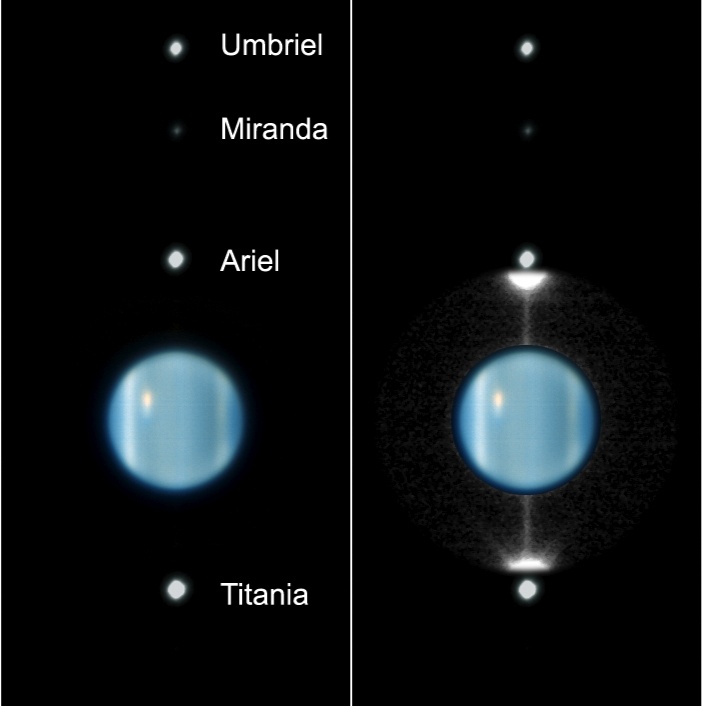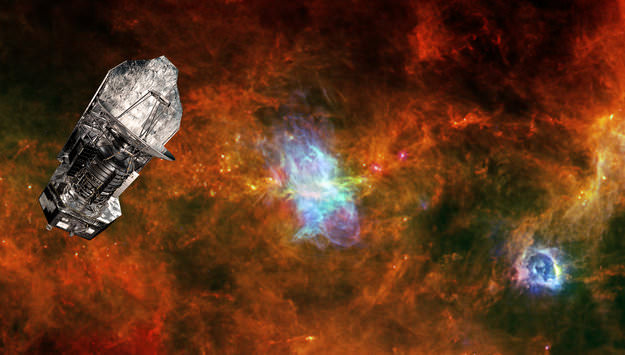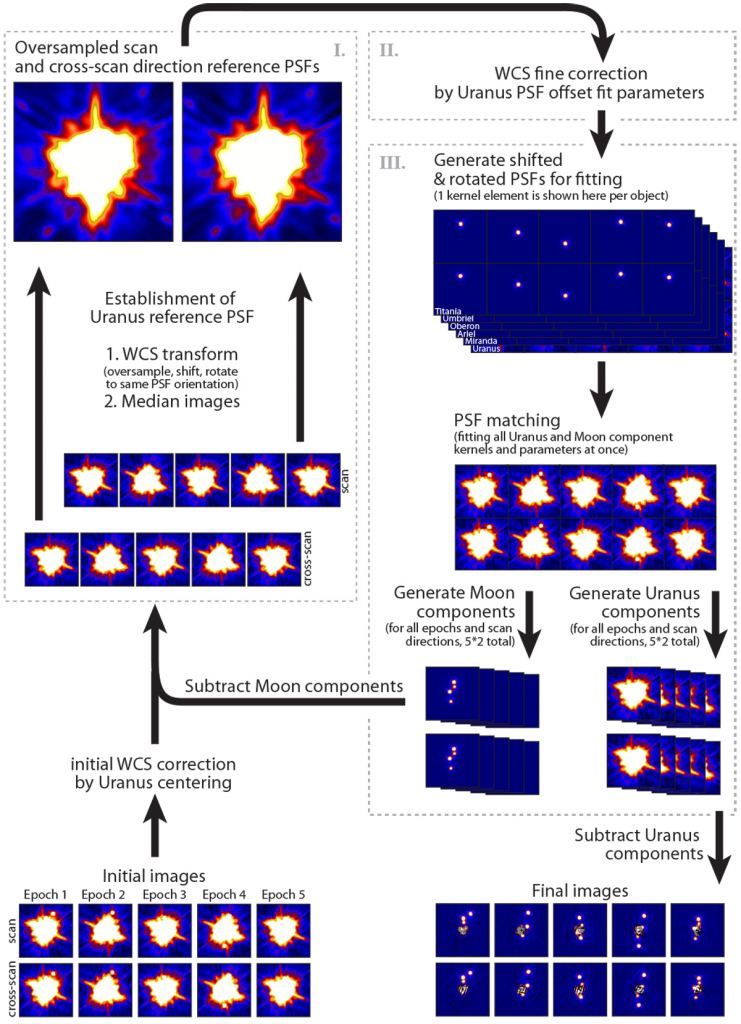Astronomer William Herschel discovered Uranus—and two of its moons—230 years ago. Now a group of astronomers working with data from the telescope that bears his name, the Herschel Space Observatory, have made an unexpected discovery. It looks like Uranus’ moons bear a striking similarity to icy dwarf planets.
The Herschel Space Observatory has been retired since 2013. But all of its data is still of interest to researchers. This discovery was a happy accident, resulting from tests on data from the observatory’s camera detector. Uranus is a very bright infrared energy source, and the team was measuring the influence of very bright infrared objects on the camera.
The images of the moons were discovered by accident.
Uranus is difficult to observe. NASA’s Voyager 2 is the only spacecraft to have ever visited the planet, and that visit taught us a lot. Even telescopes like the Hubble have difficulty.
The team of researchers behind this study were working with a new method of analysing data from the Herschel Space Observatory and its Photodetecting Array Camera and Spectrometer (PACS). PACS was a low resolution spectrometer and imaging camera in one. It operates in the infrared, and gathered sharper images than any of its predecessors.
The paper presenting the team’s finding is titled “Herschel-PACS photometry of the five major moons of Uranus.” It’s published in the journal Astronomy and Astrophysics, and the lead author is Örs H. Detre of the Max Planck Institute for Astronomy (MPIA).
“We were all surprised when four moons clearly appeared on the images, and we could even detect Miranda, the smallest and innermost of the five largest Uranian moons.”
Örs H. Detre, Lead Author, Max Planck Institute for Astronomy.
In the abstract from their paper the team stated their aims: “We aim to determine far-infrared fluxes at 70, 100, and 160 ?m for the five major Uranus satellites, Titania, Oberon, Umbriel, Ariel, and Miranda.” They didn’t conduct any new observations for their work. Instead, they worked with data from Herschel’s PACS.
One thing the Herschel Observatory lacked was a coronagraph. A coronagraph blocks out powerful sources of light, allowing astronomers to see faint objects in the same vicinity as the powerful light. They’re used on solar observatories, where they block out the glare from the Sun, allowing researchers to see coronal mass ejections and other solar phenomena. Without a coronagraph, faint objects are simply lost in all that light. In this case, the bright infrared light coming from Uranus meant it was almost impossible to see its nearby moons.

Without a coronagraph, Detre and his colleagues had to be clever.
“Actually, we carried out the observations to measure the influence of very bright infrared sources such as Uranus on the camera detector,” explains co-author Ulrich Klaas, who headed the working group of the PACS camera of the Herschel Space Observatory at MPIA. “We discovered the moons only by chance as additional nodes in the planet’s extremely bright signal.”
In PACS’ wavelength range, cooler objects radiate brightly. Uranus and its moons are warmed by the Sun to between about -213 C to -193 C (60 and 80 K). So they appear as bright objects, with the light from Uranus overwhelming the mooons.
Uranus’ axial tilt is 97.77 degrees, so it’s basically orbiting on its side, perpendicular to the ecliptic. The moons also conform to this arrangement, so they’re inclined towards their orbit around the Sun. As Uranus orbits around the Sun, it’s primarily either the northern or southern hemisphere that’s lit up.

The timing of the PACS observations of Uranus and its five moons was very fortunate.
“The timing of the observation was also a stroke of luck,” explains Thomas Müller from MPE. “During the observations, however, the position was so favourable that the equatorial regions benefited from the solar irradiation. This enabled us to measure how well the heat is retained in a surface as it moves to the night side due to the rotation of the moon. This taught us a lot about the nature of the material,” explains Müller, who calculated the models for this study.
These observations were lucky because Uranus isn’t lit up this way very often. It takes 84 years to complete one orbit, and hasn’t even completed three orbits since its discovery. So it was definitely fortunate that the Herschel Space Observatory was operating during that window.

Watching Uranus and its moons as they absorbed then released heat was critical to this study. Muller was surprised by what he found. The surfaces of the five moons, Titania, Oberon, Umbriel, Ariel, and Miranda, absorbed heat surprisingly well, and they released it more slowly than expected.
The heat retention and release properties of the moons reminded the team of another family of Solar System objects: dwarf planets at the outer edge of the Solar System. Bodies like Pluto and Haumea. These results set the five major moons of Uranus apart from the other, smaller, irregular moons that orbit the planet.

“We established improved thermophysical models of the five major Uranus satellites,” the authors write in the conclusion of their paper. “Our derived thermal inertia values resemble those of trans-neptunian object (TNO) dwarf planets, Pluto and Haumea, more than those of smaller TNOs and Centaurs at heliocentric distances of about 30 AU.”
“In summary,” the researchers continue, “the Uranian satellites Oberon, Titania, Umbriel, Ariel, and Miranda have thermal inertias which are higher than the very low values found for TNOs and Centaurs at 30 AU heliocentric distance. It seems that the thermal properties of the icy satellite surfaces are closer to the properties found for the TNO dwarf planets Pluto and Haumea.”
“This would also fit with the speculations about the origin of the irregular moons,” adds Müller in a press release. “Because of their chaotic orbits, it is assumed that they were captured by the Uranian system only at a later date.” The characteristics of the smaller irregular moons are similar to more distant, smaller, and more loosely bound TNOs. Only the five major mooons were formed in-situ, and resemble objects like Pluto.
In the PACS observing range, Uranus appears overwhelmingly bright. That brightness overwhelms nearby objects like the five major moons. The nature of PACS means that infrared light from Uranus can spread out over the rest of the image. That isn’t critical for very distant objects like other stars. But for something like Uranus, entire moons can be blocked out.
“The moons, which are between 500 and 7400 times fainter, are at such a small distance from Uranus that they merge with the similarly bright artifacts. Only the brightest moons, Titania and Oberon, stand out a little from the surrounding glare,” said co-author Gábor Marton from Konkoly Observatory in Budapest, in a press release.
This is what’s at the heart of this research. The team developed new data processing techniques to bring the moons back into view, and eliminate the blinding glare. The idea was to reduce enough light to make the moons visible again, so that the team could reliably measure their brightness. It’s like trying to introduce the power of a coronagraph into images that were made without one.

“In similar cases, such as the search for exoplanets, we use coronagraphs to mask their bright central star,” Detre explains. “Herschel did not have such a device. Instead, we took advantage of the outstanding photometric stability of the PACS instrument.”
The team calculated the exact positions of the moons themselves when the images were taken, then used that knowledge to remove Uranus itself, and all its brightness, from the image.
“We were all surprised when four moons clearly appeared on the images, and we could even detect Miranda, the smallest and innermost of the five largest Uranian moons,” Detre concludes.

This study shows how valuable archived observational data can be. There are valuable scientific discoveries hidden in the data from expired missions like Herschel. In April 2020, for example, scientists examining data from NASA’s Kepler planet-finding mission found an Earth-sized planet in its star’s habitable zone.
“The result demonstrates that we don’t always need elaborate planetary space missions to gain new insights into the Solar System,” co-author Hendrik Linz from MPIA points out. “In addition, the new algorithm could be applied to further observations which have been collected in large numbers in the electronic data archive of the European Space Agency. Who knows what surprise is still waiting for us there?”
More:
- Press Release: Herschel and the Uranian moons
- New Research: Herschel-PACS photometry of the five major moons of Uranus
- Universe Today: Something Twice the Size of Earth Slammed into Uranus and Knocked it Over on its Side

